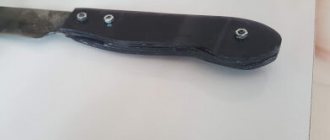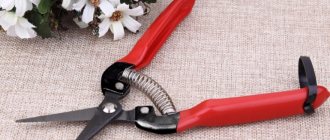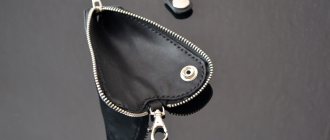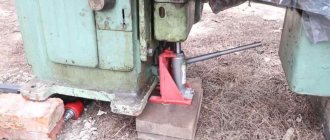Roller shears and sheet metal cutting features
In the metalworking industry, roller shears or knives are used to process sheet material. This tool is called knives because its operation is based on the use of two cutting discs. The cutting process is based on the fact that rollers are pressed into the sheet material from two sides - top and bottom. In this case, it is cut without the use of any sharp knives. The role of cutting and sharp knives is played by rollers, which touch the walls to each other on both sides.
Rollers not only cut sheet material, but also facilitate the process of moving the tool along the surface of the sheet. This means that cutting with a roller knife is not only convenient, but also effective. If we compare the operation of the device with hand scissors, the following advantages should be noted:
- Speed - cutting a sheet of steel with roller shears can be done in a matter of seconds, but using scissors requires a lot of time, which depends on the length of the material being cut
- Cut quality - the roller knife cuts not only quickly, but also with high quality. There are no chips, bends, bends, etc. at the site of the cut
- Physical fatigue - cutting with hand scissors requires physical effort, while using a roller tool eliminates this need. To cut, you only need to move the roller shears along the guides, thereby cutting the steel sheet
Roller shears are classified according to the types of knives into three types:
- They are located in parallel. The most popular type of cutting tool, which is intended exclusively for cutting material into strips, that is, cutting is performed in a straight direction
- They have one slope. They are intended for cutting not only even strips of sheet material, but also for cutting round and ring-type workpieces
- With several slopes. Such roller devices are intended directly for cutting workpieces of various shapes - ring, round, curved, etc.
After cutting, the edge of the material does not need additional processing, as it turns out smooth, without chips or burrs.
Types of lever scissors
The designs of lever cutters do not differ in variety; the main difference is in the type of drive:
- manual - the most primitive device; by pressing the lever, the cutting blade is set in motion;
- electric - they work very quickly and are highly efficient. Cutting metal on such equipment does not require any effort from the worker;
- hydraulic - powerful, driven by a hydraulic drive. Widely used when large forces are required, for example, for cutting reinforcement or rods.
Hand scissors are divided depending on their purpose and design:
- with straight blades - used only for cutting in a straight line;
- with curved cutters - they are used to cut out complex shaped elements and holes;
- chair - used for cutting thick layers of paper;
- finger - make holes with very thin incisors;
- lever - permanently mounted on a workbench.
The manual lever attachment allows for through or straight cutting on a straight line only.
In addition, the tools differ in the length of the actuators:
- with short blades for through cutting;
- with long cutting surfaces - for straight cutting;
- combined scissors for all types, including contour scissors.
Cutting small parts with lever scissors is impossible; they are convenient for large cutting or chopping work.
The tool can be stationary or portable. For work, both types are firmly fixed on a workbench or bed. This is the only way to cut metal accurately and safely. To secure portable scissors, use clamps or bolts.
How to cut sheet metal at home
In industry, roller shears are used to cut factory-produced sheet metal. Their distinctive features are high accuracy, long service life, and the absence of the need to make them yourself. Often in the household there is a need to obtain even strips of sheet steel, which are used for various purposes. If you need one strip, then there is no need to buy or make such a device, since you can use ordinary metal scissors. If you need to cut the entire sheet or carry out cutting work regularly, then it is imperative to acquire a roller knife.
There is no justifiable sense in buying such a factory-made device, since the price ranges from 15 thousand rubles or more, which depends on the design, size and quality of the device. Roller shears for cutting sheet metal can be made with your own hands at home, using available consumables for manufacturing. Although this method requires time, it allows you to save money, resulting in a universal cutting tool for cutting sheets of stainless steel, galvanized steel, etc.
This is interesting!
It should be noted that roller shears are only suitable for cutting flat sheets, and they cannot be used to cut sheets with protrusions and recesses, for example, corrugated sheets in the transverse direction.
Limitations of lever shears and how to overcome them
The main disadvantage of lever shears that do not have a mechanical drive is the need to make very long movements in order to reduce the force of cutting metal. In addition, with a manual drive it is impossible to ensure a constant cutting speed, which can deteriorate the quality of the metal cutting surface. By lengthening the drive, you have to sacrifice the overall dimensions of the equipment. In addition, lengthening the arm always worsens control over the quality of the workpiece clamp, and requires the use of more powerful clamps that hold the cut metal from moving. At the same time, there is also no possibility for high-quality cutting of profiled products: rods, angles, etc.
These limitations are overcome by designs with a multi-link cutting mechanism, as well as by the use of various methods of reinforcement without the participation of muscular force. In this case, a mechanical drive is not required.
Cutting Rules
In the first case, predominantly kinematic schemes with two levers are used. An additional one is added to the main lever (each part of which is connected to the other part using a common axis), and its connection with the main pair is achieved by the presence of a cylindrical rod with a rack and pinion drive.
The rack and pinion mechanism consists of the following parts:
- intermediate lever;
- return springs;
- swivel brackets;
- a screw pair connecting the rail with the intermediate rod.
This method, although it provides higher quality metal cutting, but significantly complicates the design of lever shears. It is very difficult to make such an option at home; in addition, the worker’s effort will remain quite high.
If instead of a rack and pinion transmission a mechanical amplifier is placed in the intermediate rod, the resulting load will noticeably decrease. This type of manual lever scissors includes, in addition to the main working elements, also:
- cylindrical hollow rod;
- amplifier with self-braking thread;
- connecting rod;
- spring-loaded lock;
- counterweight.
The presence of a load gives the metal cutting process an impact character, due to which it is possible to increase the cutting energy and separate workpieces with a larger thickness or cross-sectional area. However, the shock nature of the load application tires the worker (especially during prolonged work), and the amplitude of vibration of the device on the frame increases. To install such scissors, you will need more reliable support and a flat floor surface. Metal cutting performance will also decrease.
The three-tier scheme is considered the most modern. In this case, the required compromise is achieved between the applied force and the length of movement of the movable tool.
Features of making a tool yourself
If you are tired of cutting sheet metal with scissors or a grinder, then a roller cutter is an excellent alternative to replace these tools. The advantages of this device include quiet operation and lack of energy consumption. In addition, having such a device in your home arsenal, you can even make money when your neighbors need to cut sheet metal material.
The purchase of a tool is justified only in one case, when it is necessary to perform work in large quantities. And even in this case, you can make the device yourself to use it for professional purposes. There are many designs for the devices in question, so making a device yourself is not at all difficult if you understand the principle of operation of the device.
When making a homemade tool, the following properties must be taken into account:
- Cutting knives - there should be two of them, one located on top and the other on the bottom. Knives must be made of high-quality alloy, which has a strength higher than the materials being cut. Bearings that fully meet the described requirements are used as knives.
- Base - simultaneously acts as a surface on which the steel sheet is located, as well as a guide for moving the roller shears when cutting the sheet or cutting strips
- Body of the device - for manufacturing, a steel angle with a thickness of 3 mm and a wall size of 40-60 mm is usually used
- Auxiliary tools - they are designed to secure the sheet material to the table surface while cutting it
This is interesting!
The service life of homemade roller knives is quite high, and is almost equal to that of factory models.
The service life of factory devices is at least 25 km, but provided that the thickness of the cut steel does not exceed 0.5 mm. The thicker the steel, the shorter the service life of the tool. The service life of a homemade device is influenced by such an indicator as the quality of its manufacture. Moreover, this even applies to the quality of bearings, so if you get down to business, you will need an appropriate approach.
Manufacturing instructions
Factory models of cutters sold in stores, even in standard configuration, will cost a large amount. The price of models offered on the market starts from 20,000 rubles. Such conditions are not beneficial for purchasing a tool for home use or a small workshop, and it will be used extremely rarely.
To begin with, the main body of the instrument is designed, which everyone chooses for themselves. The main attribute of the machine is manufactured - a roller knife for sheet metal. The material from which the part is made directly affects the durability and performance of the unit. As mentioned above, the strength characteristics should be significantly higher than the similar characteristics of the material being cut. Otherwise, the minimum problem will be a low-quality cut, forcing the craftsman to clean and process the edges of each cut piece.
Scheme for assembling a roller knife
Do-it-yourself roller metal shears are mostly made from bearings. Sharpening the ends of the part forms the cutting surfaces. The main roller, connected to the drive, is attached directly to the handle. The lower one is installed on the fixed lower part of the machine. If you have skills in processing iron alloys, manufacturing such a device will take a maximum of a little more than a week, including setting up the unit.
What to make a roller knife from
There are no difficulties with purchasing roller shears, since such a machine can be found in an online store and ordered. The only difficulty is that you will have to shell out a considerable amount of money to purchase it, which will not pay off soon if you do not use such equipment often. Making your own will not require any costs, but the biggest difficulty is choosing the necessary materials and assembling full-fledged roller shears from them.
Using a homemade machine allows you to cut the following types of materials:
- Cink Steel
- Stainless steel
- Aluminum
- Steel sheets up to 0.5 mm thick, for example, window slopes of metal-plastic windows
Bearings are used to make cutting knives. The diameter of these bearings depends on the size of the roller blade housing, but 20-30mm ball bearings are commonly used. In order for the bearings to ensure cutting of material, it is necessary to grind off their end faces, making them strictly at an angle of 90 degrees. The effectiveness of the tool depends on this.
This is interesting!
The diameter of the bearings affects the cutting speed. The larger the size of the bearings, the correspondingly higher the cutting speed.
Before you make a roller-type cutting tool, you need to understand its principle of use. The application is based on the fact that a homemade knife moves along guides. The corner part of a workbench or table is used as such guides. The sheet to be cut is placed on the surface of the table, and in order for the cut to be smooth and neat, it should be fixed in a stationary position. This can be done using two clamps and a wooden block of appropriate length. A block is placed on the sheet, and then it is fixed on both sides with clamps, thereby ensuring immobility during processing.
Lever shear device
The operation of manual metal shears is based on the principle of leverage. The cutting of the material is carried out by two cutting surfaces about 20 cm long. In this case, one surface is rigidly fixed to the base, and all the pressure is applied here. The movable cutter is also fixed to the frame. A groove is selected in the fixed blade to move the slider. It moves like a hinge in one plane.
The movable part of the scissors is attached to the slider. The working stroke of the slider is 15 - 32 mm. The movable panel is equipped with a long handle (about 50 cm), which increases the applied force by 20 times or more. Therefore, metal is cut quite easily.
The body of the lever scissors is metal, the cutting surfaces are made of tool steel. On average, the dimensions of the instrument are 56 x 18 x 45 cm and weighs about 30 kg. Using such equipment, you can cut a steel sheet with a thickness of 0.5 cm, aluminum or brass 0.6 mm, a profile with a section of 6x70 mm or a steel rod No. 13 with your own hands.
Instructions on how to make roller shears from bearings with your own hands
As already mentioned, there are many options for making a homemade roller cutting tool, but which one to choose for yourself depends not only on the capabilities, but also on the availability of the necessary consumables. If you need a simple homemade roller knife, you can make it from bearings. The manufacturing principle is simple, and first let’s figure out what tools and materials will be needed to make it:
- Two bearings 204 or 205. You can use other bearings that are available. They don't have to be the same size
- Corner 50-60 mm up to 30 cm long
- Threaded connectors, washers, nuts and other small consumables
- Steel tube from which to make a handle for roller shears
- The tools you will need are a welding machine, as well as a drill and grinder
When all the necessary materials are ready for work, you can get down to business. Instructions for making a roller knife yourself are as follows:
- First you need to prepare a corner, since it will act as a body on which additional elements will be placed
- We grind the edge of the bearings. Moreover, this must be done in such a way that the resulting edge has an acute angle. On both bearings it is necessary to “remove” the edge, since the possibility of using the roller shears for their intended purpose depends on this
- Next, you need to drill a hole in the corner and attach one bearing to it. A bolt with a countersunk head is used for fastening. A washer is also used to secure the bearing, which will ensure reliable pressure against the wall of the angle
- The bearing is attached so that its outer race protrudes 1-2 mm from above the edge of the angle. It is important to provide for the possibility of adjusting its contact with the second bearing by placing washers on the inside
- On the reverse side, when securing the bearing, it is necessary to ensure that the head of the fastening bolt is recessed into the base of the angle. This is necessary so that the homemade tool can move freely along the edge of the workbench. If you can’t drown the hat, you can make a groove for it in the workbench design, which is also quite appropriate when using homemade scissors
- The first part of the work at this stage is considered completed, so you should proceed to the manufacture of the second part. This is the handle, the second bearing, and also the sheet bender
- Using a similar corner that is 2 times shorter in length, you need to attach the second bearing to it. First, using a grinder, you need to cut the corner into the shape shown in the photo below.
- It is necessary to attach the bearing to the end part of the resulting workpiece by first drilling a hole
- Weld the corner piece to the main part as shown in the photo. It is important to take into account that the upper bearing must be in close contact with the lower bearing, and its outer race must be located at a distance of up to 1 mm from the base of the angle
- Finally, you need to attach the handle to the resulting installation so that it is convenient to work
The result is a homemade cutting tool for cutting metal sheets up to 0.5 mm thick. When using the device, it must be taken into account that it is intended exclusively for working with sheet materials. During operation, the edge of the bearings will wear out, so it is advisable to provide during manufacturing the possibility of adjusting the contact of the bearings. All the details of the manufacture and use of such a tool are in the video below.
This is interesting!
When you rotate one bearing by hand, the second should also rotate, which indicates that the homemade product was manufactured correctly.
The greater the distance between the end parts of the bearings, the lower the quality of the tool. In conclusion, as an example, it is worth giving an example of how much a factory roller blade costs, as well as what technical parameters it has. For example, consider a Trim Cutter 3017 brand machine and its technical parameters:
- Maximum sheet metal thickness - 0.7 mm
- The weight of the device is 4 kg
- Overall dimensions - 220x180x260 mm
- Cost from 25,000 rubles
Based on the above, it can be noted that making roller shears for cutting thin sheet metal with your own hands is not at all difficult. This does not require a lot of effort and consumables. With just 3-4 hours of free time, you can make a highly effective cutting tool at home. With roller shears, you don’t need to think about how to cut a metal sheet when installing window slopes or how to cut galvanized sheets into strips, since with it any similar work is carried out easily, quickly and efficiently.
Three-link lever shears
It has been established that the scheme, which will be described below, can cut long and sheet metal with a cross-sectional size of up to 10 mm, which in most cases is sufficient not only for one’s own needs, but also for the manufacture of steel products in a small business.
These scissors consist of the following components:
- A frame, for the manufacture of which you will need two equal-sized corners with a shelf thickness of at least 7 mm.
- The lower support to which the working tool is attached.
- The upper support, which is installed in the seat, and has a bevel in order to reduce the gap between the knives at the moment the cutting begins.
- The housings in which the mounting holes for the knives should be made slightly oval in shape to compensate for possible errors in the installation of the tool.
- Earrings.
- Connecting axis.
- Fasteners.
For the manufacture of all parts of the multi-link mechanism, medium alloy steel grade 35 or higher will be required.
The length of the support frame is determined by the maximum dimensions of the metal being cut: the size of hand shears will be approximately twice the width of the workpiece. However, the design turns out to be quite compact, and allows you to use a regular bench vice and a workbench of appropriate size for installation.
The working tool attachment scheme is as follows. In the equipment made from high-strength tool steel grades U10 or U12, mounting holes are made with a countersunk conical part so that the fastening is flush-mounted. The kit should include options for cutting profiled metal. To facilitate maintenance, the equipment should be made double-sided. Next, heat treatment is carried out to a hardness of at least 54...56 HRC, and grinding is carried out in order to eliminate possible warping of the working blade. The finished equipment is installed in the lower and upper landing parts, and is adjusted one after the other in such a way that the actual gap between the moving and stationary parts does not exceed 5...8% of the thickness of the metal being cut.











